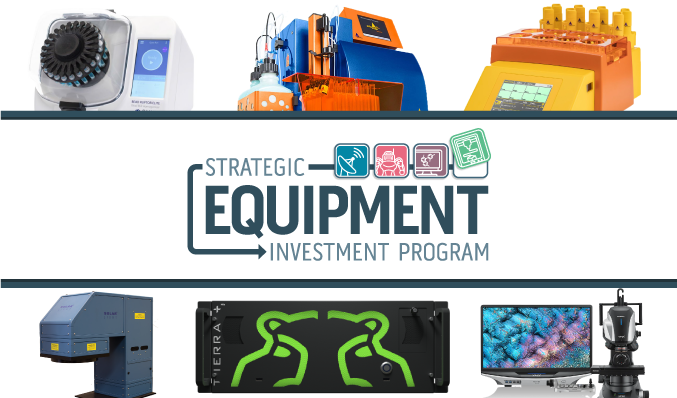The Strategic Equipment Investment Program, provided by the Office of the Vice President for Research and Partnerships, has funded five proposals to purchase equipment expected to advance research and creative activities at the University of Oklahoma.
SEIP supports funding for the purchase of strategic equipment that enhances a team’s capabilities and competitiveness at a national level, specifically, the equipment is expected to “provide new opportunities for advancing the team’s ability to achieve new goals in terms of creativity, discovery, innovation, and competitiveness in securing external funding.”
John Antonio, senior associate vice president for research and partnerships, oversaw the peer-review application process.
“In addition to the merit of the equipment being supported, another aspect of this year’s SEIP program is that the funding is nearly double what it was last year,” he said. “This year’s program provided about $200,000 from the VPRP, with a total of $125,000 in cost-share being provided by our partnering academic colleges and departments. This illustrates the strength of our campus partnerships and our shared belief in the importance of making strategic investments in state-of-the-art equipment. This equipment is critical to accomplishing the faculty’s research and creative activity aspirations aligned with the goals of OU’s Lead On strategic plan.”
The funded proposals are:
LS-100 UV Solar Simulator – proposal led by Chemical, Biological and Materials Engineering faculty Ngoc Bui, Steven Crossley, Bin Wang, Brian Grady, as well as Randall Kolar (Civil Engineering and Environmental Science)
The solar simulator, or artificial sun, will provide a controllable lab-scale indoor testing facility for a wide range of research. In the proposal, Bui describes three research themes that will be supported by the solar simulator: solar-driven electrolytic water splitting for H2 production, photo(electro)chemical degradation of organic contaminants from (waste)water streams, and solar-thermal-driven membrane distillation for the treatment of produced water from oil and gas industry. Longer term plans will also provide research pathways for sustainably converting solar energy to liquid fuels via photoelectrochemistry.
Comprehensive System for Cell Separation and Analysis – proposal led by Stephenson School of Biomedical Engineering faculty John R. Clegg (Stephenson Cancer Center (SCC) affiliate faculty), Wei Chen (SCC affiliate faculty), Handan Acar (Institute for Biomedical Engineering, Science and Technology (IBEST) member and SCC affiliate faculty), Michael Detamore (SBME Director), and Jacob “Jed” E. Friedman (Harold Hamm Diabetes Center)
This SEIP award will cost share the purchase of a comprehensive system for cell separation and analysis, which will expand research capabilities for immunoengineering. Three instruments – a tissue dissociator, magnetic cell separator, and bead mill homogenizer – will work semi-automated and in-sequence to process whole tissues into purified biomarkers (subsets of cells, proteins or nucleic acids) for analysis. This equipment will support expansion of current research in immunoengineering and drug delivery, while also facilitating collaboration with OU Health Sciences Center researchers.
Optical microscope for SRNML core user facility – proposal led by Iman Ghamarian (Aerospace and Mechanical Engineering), Tingting Gu (Biology), Yingtao Liu (Aerospace and Mechanical Engineering), and Andrew Elwood Madden (SRNML)
The Keyence VHX-7000 series, a 4K, ultra-high-accuracy optical microscope, will be managed by the Samuel Roberts Noble Microscopy Laboratory, a shared-use core facility. In their proposal, Ghamarian et al. say the microscope will address multidisciplinary needs for high-resolution visible-light imaging with a wide field of view for materials such as metals, polymers, composites, geomaterials, biological and archaeological samples. Specifically, the microscope will allow users “to easily and rapidly collect very high-quality images up to 6000x and data sets that can be used for 3D surface rendering and analysis” and will support research and education in fabrication and characterization across length scales via correlative data analysis.
Green Hippo 3-D Projection Mapper – proposal led by Helmerich School of Drama Director Seth Gordon with drama faculty Jon Young, Richard Sprecker, Uldarico Sarmiento, Renée Brode, as well as University Theatre Technical Director Ashley Hungerford and University Theatre Production Electrician Eric Stehl
The Green Hippo will enable students, faculty and staff in the Helmerich School of Drama to learn and create with project mapping, a 3-D video projection technique using light and colors to project visual images on irregular shapes and non-flat surfaces. Gordon says faculty and students will use this device in University Theatre productions, “making it an experiential learning opportunity fundamental to the success of productions associated with the Schools of Drama, Musical Theatre, Dance, and Music.” The Hippotizer is also highly energy efficient and will enable technical and creative advancements in a way that is environmentally sustainable. With this equipment, OU Drama will become a regional leader in design and production of all forms of entertainment. OU faculty and staff knowledge of how to operate and use the equipment in creative ways will increase their creative and professional capabilities, providing them with unique skills and knowledge.
Electroporator for High-Efficiency Cas9 Gene Editing – proposal led by Department of Chemistry and Biochemistry Associate Professor Rakhi Rajan, Zhibo Yang and Laura-Isobel McCall, as well as Stefan Wilhelm (Stephenson School of Biomedical Engineering)
The Neon transfection system will be used to reliably perform gene editing experiments and decrease variability found through current chemical transfection methods. This model can support protein, RNA and DNA transfection, which will enable researchers to test a range of different CRISPR-Cas9 delivery options. In the proposal Rajan said, “…the targetability of natively low editable sites can be drastically improved. Neon transfector’s adjustable parameters for electric pulses makes this instrument adaptable to a wide range of cell lines, which will be important to adapt to future scientific requirements including collaborative research using new cell models.”


